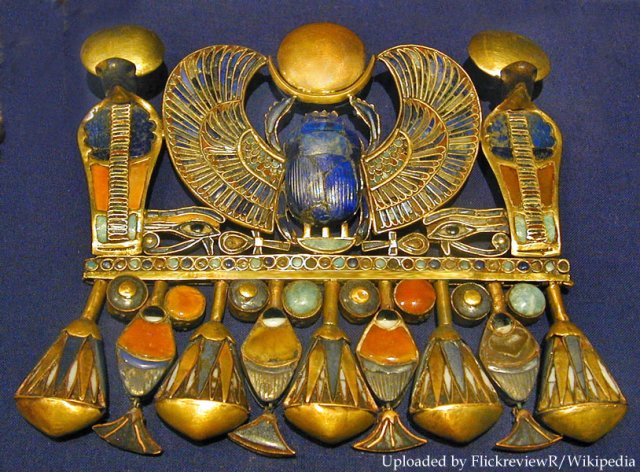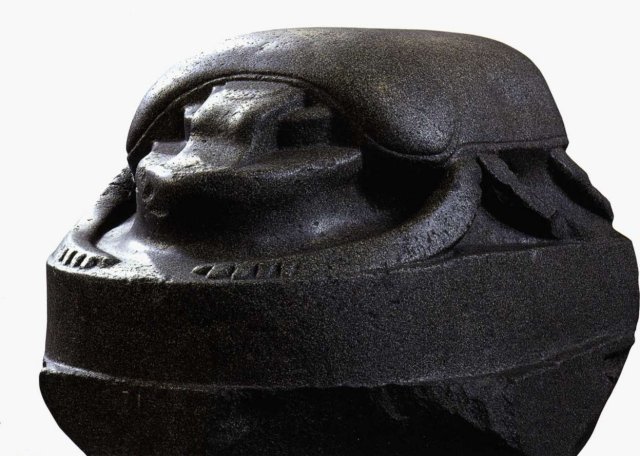Secrets Of The Scarab – Ancient Sacred Symbol In Human History
A. Sutherland - AncientPages.com - Ornaments in the shape of beetles are known from the late Paleolithic epoch (10,000 to 20,000 years ago). However, so much earlier than the Egyptian civilization, it is difficult to know the exact meaning these people attributed to beetle body ornaments.
Statue of Khepri, the sacred scarab in Karnak Temple Complex Luxor. Credit: Adobe Stock - Mountains Hunter
Scarab is one of the ancient Egyptians' oldest and most widely used symbols. Egyptian pharaohs worshipped dung beetles; most probably, it was symbolically as sacred to the Egyptians as the cross is to Christians.
The scarabs with aesthetic qualities and shamanic symbolism were already known in the Old Kingdom (3rd millennium BC) and played an important role in the early worship of animals. It is supported by archaeological evidence discovered in graves during the time of King Den of Dynasty I.
Sir W. M. Flinders Petrie, in Scarabs and cylinders with names, writes that many different kinds of beetle were sacred and venerated in ancient Egypt. Evidence of this can be seen on many jars, found in graves containing numerous dried beetles, both large and small, and many amulets, especially in the form of large sacred Scarabeus sacer.
Particularly well-known is an amulet depicting 'the sun - the big ball rolled across the heaven by the Creator, and the scarab is an emblem of the Creator, Khepera...' or the sun god Khepri (Kheper (a), in the mythology of ancient Egypt, 'the Father of the Gods' and this symbolism of the beetle is a part of the primeval animal worship of ancient Egypt.
The 'Kheper' is 'being' and means existence, creation, or becoming; so, the god Khepera is the self-existent creator god.'
Winged scarab of Tutankhamun with semi-precious stones. This pectoral is composed of Tut's Prenomen name: "NebKheperU-Ra", the hieroglyphs of: Basket, Scarab-(in Plural-strokes), and Re. Credit: Jean-Pierre Dalbéra, Flickr - CC BY 4.0
The scarab was depicted with the disc of Ra in its claws in the 12th, 18th, and later dynasties and associated with other gods as a creative emblem.
Millions of amulets and stamp seals of stone or faience were fashioned in Egypt with depictions of the scarab beetle, and this tradition survived well beyond the dynastic periods.
'On the passing to the 23rd dynasty and later the winged scarab was placed on the breast of the mummies, as the emblem of the Creator, who will transform the dead, and from the 26th to the 30th dynasties, many scarabs were placed on the mummy, usually a row of half a dozen or more along with the figures of the gods.' (W.M.F.Petrie)
Ornament from an ancient Egyptian sarcophagus with Scarab Beetle. Credit: Adobe Stock - Juulijs
In Roman times, there were various kinds of beetles and the Greeks adopted the carved stone columns, which seems to confirm the importance of the sacred temples of the Egyptian scarabs:
"I am Cheprer, a student, and when I spread wings, back to life."
The sacred 'Chilam Balam' books written by the Maya describe the scarab as a dirt ground, in terms of material and moral, which is destined to become a saint, and in China, we find the same symbolic interpretation in 'the scarab rolls its ball, which is called by life.'
'The scarabaeus rolls his ball and in the ball there develops life as the result of the undivided effort of his spiritual concentration. If now an embryo can grow in manure and shed its shells, why then should not the dwelling place of our heavenly heart also be able to create a body if we concentrate the spirit upon it..? we read in the 'The Secret of the Golden Flower" - A Chinese Book of Life, translated in 1931).
The famous text of “The Secret of the Golden Flower,” takes the sacred scarab as an example of the “work to be done” to reach spiritual immortality, either material (for the body), or spiritual (for the soul).
This is a giant sculpture of a scarab beetle. It is around one and a half meters long and is one of the largest known representations of a scarab beetle. This scarab is thought to be from the Ptolemaic period (305-30 BC) but could be earlier. It may once have stood in an Egyptian temple but it was found in Constantinople (modern Istanbul) in Turkey. It may have been taken from Egypt to Constantinople when the city became the capital of the Later Roman Empire in AD 330. Image credit: British Museum.
It is a goal of the Taoism philosophy, which believes in the strengths of various material “pellets” that aid in reaching immortality.
The scarab dung ball was identified as one of these important 'pellet substances'.
Many beetle species have been and still are used as food in America, Australasia, Asia, and Africa; some were also eaten in Europe. Through Art Nouveau jewelry of the 1900s, Western civilization was richly adorned with beetles and other insects.
In Europe and North America, collars, broaches, and ear pendants used beetles mounted on bronze. Today, especially in Mexico, living specimens of some beetle species are worn by women as broaches, attached with a small gold or bronze chain.
By the way, some say that the scarab worn as a pendant around the neck can cause disease of the throat and larynx. Or is it only an illusion...?
Updated on February 23, 2024
Written by A. Sutherland - AncientPages.com Senior Staff Writer
Copyright © AncientPages.com All rights reserved. This material may not be published, broadcast, rewritten or redistributed in whole or part without the express written permission of AncientPages.com
Expand for referencesReferences:
Myer, I. Scarabs The History, Manufacture and Symbolism of the Scarabæus
in Ancient Egypt, Phoenicia, Sardinia, Etruria, etc.
More From Ancient Pages
-
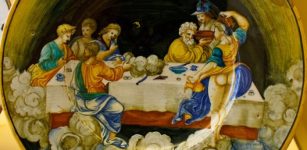 Amrita: Potion Of Immortality Consumed By Gods To Make Them Strong And Immortal
Featured Stories | Apr 5, 2019
Amrita: Potion Of Immortality Consumed By Gods To Make Them Strong And Immortal
Featured Stories | Apr 5, 2019 -
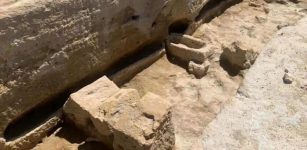 Rare Phoenician Necropolis Discovered In Andalucia, Spain Is Extraordinary, Scientists Say
Archaeology | May 2, 2022
Rare Phoenician Necropolis Discovered In Andalucia, Spain Is Extraordinary, Scientists Say
Archaeology | May 2, 2022 -
 Why Were Swords So Important To Ancient Vikings?
Ancient History Facts | Oct 4, 2017
Why Were Swords So Important To Ancient Vikings?
Ancient History Facts | Oct 4, 2017 -
 2,600-Year-Old Blocks Of White Cheese Discovered At Giza’s Saqqara Necropolis, Egypt
Archaeology | Sep 15, 2022
2,600-Year-Old Blocks Of White Cheese Discovered At Giza’s Saqqara Necropolis, Egypt
Archaeology | Sep 15, 2022 -
 Curly Hair Protected The Brain Of Early Humans And Helped It Grow
Human Beginnings | Aug 31, 2023
Curly Hair Protected The Brain Of Early Humans And Helped It Grow
Human Beginnings | Aug 31, 2023 -
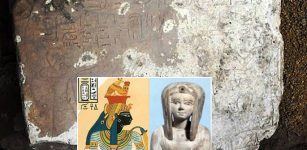 Limestone Stela Of Liberation Discovered In Kom Ombo Temple In Aswan, Egypt
Archaeology | Oct 17, 2018
Limestone Stela Of Liberation Discovered In Kom Ombo Temple In Aswan, Egypt
Archaeology | Oct 17, 2018 -
 Baalbek: Were The Megaliths Put In Place Under Herod?
Archaeology | May 27, 2019
Baalbek: Were The Megaliths Put In Place Under Herod?
Archaeology | May 27, 2019 -
 Proteus: Prophetic Greek Sea God Who Knew All Things, Past, Present And Future
Featured Stories | Jan 17, 2020
Proteus: Prophetic Greek Sea God Who Knew All Things, Past, Present And Future
Featured Stories | Jan 17, 2020 -
 Charles VI Of France – The King Who Was Made Of Glass
Featured Stories | Jan 22, 2016
Charles VI Of France – The King Who Was Made Of Glass
Featured Stories | Jan 22, 2016 -
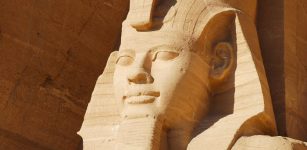 How Ramesses II Became The Greatest Pharaoh In Egypt
Featured Stories | Jun 6, 2021
How Ramesses II Became The Greatest Pharaoh In Egypt
Featured Stories | Jun 6, 2021 -
 Ancient People In Peru Had A Unique Response To The Looting And Destruction Of Their Ancestors’ Graves
Archaeology | Feb 3, 2022
Ancient People In Peru Had A Unique Response To The Looting And Destruction Of Their Ancestors’ Graves
Archaeology | Feb 3, 2022 -
 Thousands Of Sacred ‘Images’ With Unknown Signs Hidden In A Monastery Could Be World’s Oldest Alphabet
Featured Stories | Jun 9, 2021
Thousands Of Sacred ‘Images’ With Unknown Signs Hidden In A Monastery Could Be World’s Oldest Alphabet
Featured Stories | Jun 9, 2021 -
 Mysterious Marcahuasi, Peru – One Of The Greatest Puzzles Of Human Prehistory
Featured Stories | Oct 2, 2015
Mysterious Marcahuasi, Peru – One Of The Greatest Puzzles Of Human Prehistory
Featured Stories | Oct 2, 2015 -
 Did Etruscans Solve The Mystery Of Synchronicity And The Secret Language Of The Stars?
Civilizations | Jul 5, 2018
Did Etruscans Solve The Mystery Of Synchronicity And The Secret Language Of The Stars?
Civilizations | Jul 5, 2018 -
 New Entrances To Ancient Underground City In Kayseri, Turkey – Found Accidentally
Archaeology | May 1, 2020
New Entrances To Ancient Underground City In Kayseri, Turkey – Found Accidentally
Archaeology | May 1, 2020 -
 Powerful Thunderbird Sent By The Gods To Protect Humans From Evil In Native American Legends
Featured Stories | Mar 26, 2017
Powerful Thunderbird Sent By The Gods To Protect Humans From Evil In Native American Legends
Featured Stories | Mar 26, 2017 -
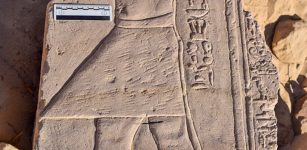 2nd Century Roman Temple Unearthed In Aswan, Egypt
Archaeology | Feb 23, 2018
2nd Century Roman Temple Unearthed In Aswan, Egypt
Archaeology | Feb 23, 2018 -
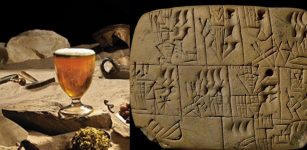 World’s Oldest Paycheck Reveals Ancient Sumerian Workers Were Paid In Beer
Ancient History Facts | Nov 22, 2018
World’s Oldest Paycheck Reveals Ancient Sumerian Workers Were Paid In Beer
Ancient History Facts | Nov 22, 2018 -
 Oldest Human Genome From The Iberian Peninsula Helps Reconstructing Human History
Archaeology | Mar 1, 2023
Oldest Human Genome From The Iberian Peninsula Helps Reconstructing Human History
Archaeology | Mar 1, 2023 -
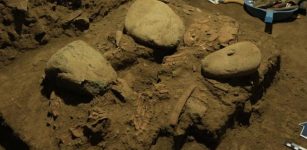 Mysterious Toaleans – Remains Of Unknown Humans Who Lived 8,000 Years Ago Discovered In The Leang Panninge Cave
Archaeology | Aug 26, 2021
Mysterious Toaleans – Remains Of Unknown Humans Who Lived 8,000 Years Ago Discovered In The Leang Panninge Cave
Archaeology | Aug 26, 2021


